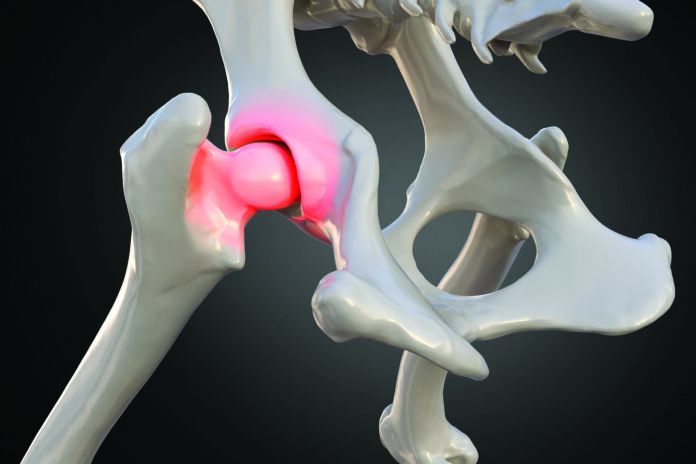Hip dysplasia is one of the most frequently occurring musculoskeletal diseases to befall dogs. A genetic disorder that usually manifests itself during puppyhood, it’s a misalignment of the bones of the hip, which is a ball-and-socket affair. The ball is the roundish top of the long-stemmed thighbone, or femur. The socket is the bony pelvis. If the ball doesn’t fit into the socket just so while a dog moves about, the grinding and chafing during walking and running (rather than the smooth gliding of the bones that’s supposed to happen) causes pain, an abnormal gait, and degeneration of the hip joint — which only makes the pain worse.
“Both Labrador and golden retrievers are commonly affected,” says Tufts orthopedic surgeon Michael Kowaleski, DVM, “as are German shepherds. Newfoundlands are another commonly affected breed. But a dog of any breed and size may develop hip dysplasia that begins to evidence itself by the time the animal is just several months old. Typical signs include limping or a ‘bunny-hop gait’ — running with both hind legs like a rabbit. The dog may also not want to play, which of course is highly unusual for a young pup.”
Treatment choices
If the dysplasia doesn’t cause too much discomfort (in some cases it doesn’t start out causing any), it can be treated with medication and lifestyle management. Treatment options include the following:
Weight control. The last thing needed by a dog with a compromised hip joint is excess weight to increase pressure on the damaged spot. Make sure
you don’t overfeed so that he
remains trim.
Exercise moderation. The aim is to avoid activities that exacerbate lameness — perhaps movements in which a dog lands hard on her limbs — but encourage all other activities. These include walking, perhaps swimming, and maybe low-impact classes such as beginner’s agility.
Medicine. Nonsteroidal anti-inflammatory drugs (NSAIDS) help reduce inflammation and thereby decrease pain.
Supplements. Chondroprotective agents containing glucosamine and chondroitin sulfate have cartilage precursors to aid in cartilage repair. They are also mildly anti-inflammatory. The quality and quantity of the active ingredients vary, so a high-quality product chosen with the help of a veterinarian is recommended.
When surgery is the right course of action
If hip dysplasia limits your dog’s daily activities despite appropriate medical management, total hip replacement is the way to go. The surgery has come very far since it was pioneered in the 1970s. Back then, the hip replacement didn’t necessarily last the dog’s lifetime. “That’s not the case today,” Dr. Kowaleski says.
The improvement has to do with how the new joint is attached to the hip bones. Until the 2000s, both the ball and the socket were cemented in. Over time, the cement would lose its grip to some degree. That meant the implants would loosen and start to cause pain and limping all over again. But around 2004, a cementless system came into use. The bone now literally grows into the implant, and it means the new ball and socket become part of the bone structure rather than simply being attached to it.
A pre-surgical procedure called digital templating helps the implant work better, too. “We now size templates for the artificial joints using x-rays or CT scans and then employ software with the outline of the implants to see exactly how they will fit within the bone,” Dr. Kowaleski says. “That helps us determine the exact size necessary and the exact position the implants need to go in. This improvement makes a big difference.
“In addition,” Dr. Kowaleski says, “we now employ intraoperative x-ray imaging. At certain key steps in the procedure, we take x-rays to assess implant position and fit, which makes the procedure even more precise.”
Total hip replacement costs in the neighborhood of $7,500 a hip. And most often, the other hip will have to be done, too. But when you consider that a hip replacement in a person costs about $40,000, it’s a relative bargain for a well-loved animal. The life a dog gets in return for the cost of the procedure is incomparable. Whereas people with joint replacements are sometimes told to restrict their activity to some degree, once dogs recover completely from the surgery — a gradual process that takes about 4 months — they can go full force. “Some even go on to compete in agility, hunting, sled racing and other sports,” Dr. Kowaleski says.





